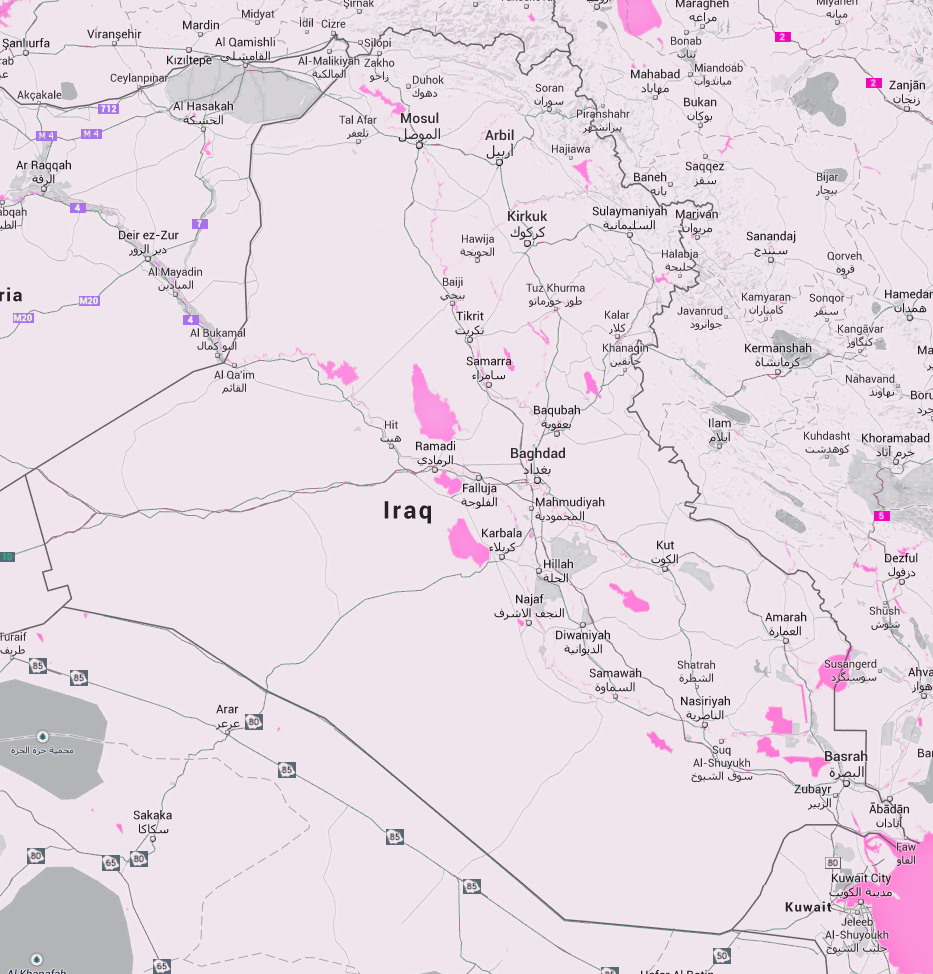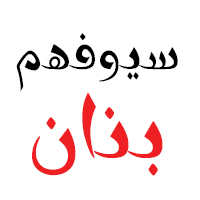TYPE DESIGN INFORMATION PAGE last updated on Fri Oct 17 11:44:52 EDT 2025
FONT RECOGNITION VIA FONT MOOSE
|
|
|
|
|
Type design in Iraq | ||
|
|
|
|
SWITCH TO INDEX FILE
Iraqi type designer who created the traditional Kufi Arabic typeface Firas (2005), which won the second prize for calligraphic Arabic type at Linotype's 1st Arabic Type Design Competition in April 2006. That typeface can be bought from Linotype. Klingspor link. [Google] [MyFonts] [More] ⦿ | |
Iraq-based type designer whose typefaces are hosted on our site. All his fonts are free for personal use. For non-personal use, please send an email to akramalzohiri@gmail.com. The list of his typefaces:
| |
Wasit, Iraq-based designer of the experimental Arabic typefaces Kofi Bloody (2014), Forat (2014), Basra (2014), Alaraby (2014) and Alkafeel (2014). [Google] [More] ⦿ | |
Arabetics
|
His typefaces include Zena (2009), Layal (2007), Mehdi (2005: follows the guidelines of the Mutamathil Taqlidi type style), Sabine (2008: it too follows the guidelines of the Mutamathil Taqlidi type style), Fallujah (2005), Mutamathil Falujah, Yasmine Mutamathil, Mutamathil Taqlidi, Arabic Mutamathil, Arabic Mutamathil Mutlaq (2004), Arabic Mutamathil Tibaah, Arabic Mutamathil Mutlaq Tibaah, Arabic Mutamathil Muttasil and Arabic Mutamathil Tibbaah Muttasil. Mutamathil and Mutamathil Taqlidi include optional Lam-Alif ligatures. See also Kufa Mutamathil (2011). Other font families: Nasrallah, Silsilah, Yasmani, Mutamathil, Yasmine Mutamathil, Amudi, Amudi Mutamathil, Anbar (2008), Handasi, Yasmine Mutlaq, Jazm (2010), Jalil (2011). In 2012, he added Nuqat, Nastarkib, Lahab, Ibrani, Hallock, Arabetics Latte (for Latin and Arabic), and Banan (Mutamathil Taqlidi type style). In 2005, he created Handasi, about which he writes: The idea behind Handasi, Arabic word for engineered, was to design a font without a single curve that would at the same time resembles traditional curves-rich Nask style. The font strictly uses straight lines. The design of Handasi is based on the Mutamathil Taqlidi design style where each letter is represented by one normal glyph assigned the basic Unicode number and an additional final shape glyph to letters capable of dual connection within traditional Arabic text. No initial, medial, or standalone shapes are provided. Arabetics Symphony (2012) is a sans serif Latin typeface with a comprehensive support for the Arabetic scripts, including Quranic texts. In 2013, he published PF Nuyork Arabic at Parachute. His Arabetic fonts from 2013 include Nagham, Arabetics Harfi (for Latin and Arabic), Camille, Raqmi and Raqmi Monoshape. In 2015, he published Hazim (in Mutamathil Taqlidi style), Sada (for small devices, in Mutamathil Taqlidi type style), Khatt, which follows the Arabetics Mutamathil Taqlidi style. Typefaces from 2016 include Mashq, possibly the first typeface implementation ever of the early Quranic scripts of the Early Mashq, Mashq Kufi, and Mashq Ma'il. The font family design is primarily based on the scripts of the Quran manuscripts of the Topkapi Museum, the Bergstraesser Archive, and other scattered samples. Typefaces from 2018: Arabetics Detroit. Typefaces from 2020: Arabetics Aladdin. Hiba Studio link. [Google] [MyFonts] [More] ⦿ |
Aziz holds a BSC in Communication Engineering 1979, Basra University, and lives in Iran (Tehran) and Iraq (Basra). In 2011, he created two new Naskh fonts called Naskh Aziz. [Google] [More] ⦿ | |
Klingspor link. Old Tasmeem fonts link. [Google] [MyFonts] [More] ⦿ | |
Diwan Mishafi
| A calligraphic Arabic typeface with over 3000 glyphs, by Diwan Software. "Mishafi contains more than three thousand shapes, making it possible for the first time to compose proper Quranic calligraphy with all their shapes, markings and recitation symbols. It is also most suitable to compose traditional text of Hadith and commentary texts in respectable form. Both classic and modern Arabic poetry can be presented by it in clear and elegant formats." The typeface was designed by the acclaimed Iraqi calligrapher Hamid Al-Saadi (b. Baghdad, 1955), and won the Type Directors Club 2000 award. [Google] [More] ⦿ |
Hamid Al-Saadi
| |
Irbil, Iraq-based designer of the monoline Kurdish font Qshtoka (2014). Free download. Earlier he made a series of 32 Arabic / Kurdish typefaces called Kazhin 1 through Kazhin 32 (2014). Free download. See also here. Behance link. [Google] [More] ⦿ | |
From Encyclopaedia Britannica: Born 10th century, Iraq, died 1022 or 1031, Baghdad. In full Abu Al-hasan 'ali Ibn Hilal Ibn Al-bawwab, also called Ibn As-sitri Arabic calligrapher of the 'Abbasid Age (750-1258) who reputedly invented the cursive rayhani and muhaqqaq scripts. He refined several of the calligraphic styles invented a century earlier by Ibn Muqlah, including the naskhi and tawqi scripts, and collected and preserved for his students numerous original manuscripts of that master. [Google] [More] ⦿ | |
A 7th century calligraphic form of the Arabic script originates from Kufa, Iraq. Modern day kufi fonts are quite squarish in appearance. [Google] [More] ⦿ | |
Arabic type foundry and design studio in Sulaymaniyah, Iraq. In 2016, they created the font families Nizar Art, Niar web serveroff, Nizar BBC Kurdish, nizar Flat, and Nizar Alhurra. Behance link. [Google] [More] ⦿ | |
The Iraq war fallout: a Berlin-based site by "Greige" where typographers who like peace submit their creations. Dingbat fonts thus far submitted and free to download: BushLanguage (2003, dingbats of the only things Bush understands), NoWarfour (2003, by Greige), NoWarone (2003, dingbats of the war mongers), NoWarthree (2003), Nwoeurope (2003, dingbats of European countries). See also their news updates. [Google] [More] ⦿ | |
Baghdad, Iraq-based designer of the sketched Latin typeface School Chalk Title (2020). [Google] [More] ⦿ | |
Type designer (b. 1957, Mosul, Iraq) who participated in the Linotype International Type design Contest in 2000 and lives in Germany, where he set up Markenbau in 2000. Author (with Roger Hübner) of Pictograms and Icons (2005, Herman Schmitz, Mainz) and Arabische Schriftkunst (1993, Hochschule der Künste Berlin). [Google] [More] ⦿ | |
Saad Dean Abulhab
| |
Kurdistan, Iraq-based designer of the rounded sans typeface family Twitter Kurdish Font (2015). [Google] [More] ⦿ | |
Iraqi calligrapher. Born in Iraq, Basra City 1974, started practicing calligraphy in 1984, when the primary school teacher Mr. Muhammad Ridha Suhail and his parents guided and encouraged him, and since that he became passionate to the art of Arabic calligraphy till he started his career as a professional calligrapher and graphic designer in 1990. After his graduation from the Civil Engineering Department from Basra University in 1996 he carried on self-taught by closely observing and studying the calligraphy of the masters of this art in Turkey like Sami Efindi, Mohammed Nazif, Hamid Al Amadi and Halim Efindi. A winner of many calligraphy competitions. Currently, Wissam works as a senior designer and consultant, specialized in brand identity and Arabic typography with global branding and advertising agencies in the UAE and abroad. In Dubai, his most noticeable works include a calligraphy wall at the Cultural and Scientific Association, the design of the Calligraphy at Mr. Majed Al Futtaim Mosque and the Calligraphy and design of the wall graphics at the Dubai International Financial Centre (DIFC). [Google] [More] ⦿ |
|
|
|
|



 Arabetics is run by the Iraqi-American New York-based type designer, librarian, and systems engineer
Arabetics is run by the Iraqi-American New York-based type designer, librarian, and systems engineer  Basim Salim Rashid El-Mahdi was born in 1973 in Alnassiriya, Iraq. He graduated from the Technology Institute / Electricity in Alnassiriya. Since 1998 he works as a graphic designer and calligraphic artist. He is now the head of the Society of Iraqi Calligraphists-Thi-Qar. Basim drew the
Basim Salim Rashid El-Mahdi was born in 1973 in Alnassiriya, Iraq. He graduated from the Technology Institute / Electricity in Alnassiriya. Since 1998 he works as a graphic designer and calligraphic artist. He is now the head of the Society of Iraqi Calligraphists-Thi-Qar. Basim drew the